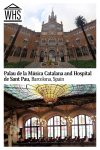Palau de la Música Catalana and Hospital de Sant Pau
By Elliott Farmer
What are Palau de la Música Catalana and Hospital de Sant Pau?
This UNESCO site is made up of two art-nouveau masterpieces of the early 20th century by modernist architect Lluís Domènech i Montaner.
Disclosure: This article contains affiliate links. Making a purchase through an affiliate link will mean a small commission for this website. This will not affect your price.
Save this pin for future reference:

Hospital de Sant Pau
The Hospital de Santa Creu I Sant Pau (to give it its full name) is an art-nouveau hospital complex constructed between 1901 and 1930, with the purpose of replacing the small medieval Santa Creu hospital in the Raval district of Barcelona. The new hospital takes its name from Pau Gil, a banker who paid for the new buildings.
By the time the new hospital entered service, the design of open wards was out of date due to airborne pandemics such as the Spanish influenza pandemic of 1918-1920. Despite this, the hospital remained in service until 2009.
From 2009 to 2014, the Hospital de Sant Pau buildings were closed for restoration and transformation into what is today called Recinte Modernista sant Pau. Several of the buildings have been restored to as they were in 1930.
What makes the Hospital de Sant Pau unique is the brightly coloured tiling, use of marble, stone capitals, stained glass, decorative brick construction and vaulted ceilings. The design and decoration are more akin to a grand house of a banker or rich merchant than a hospital. The building was constructed for public use but with a palatial aesthetic and grandeur.
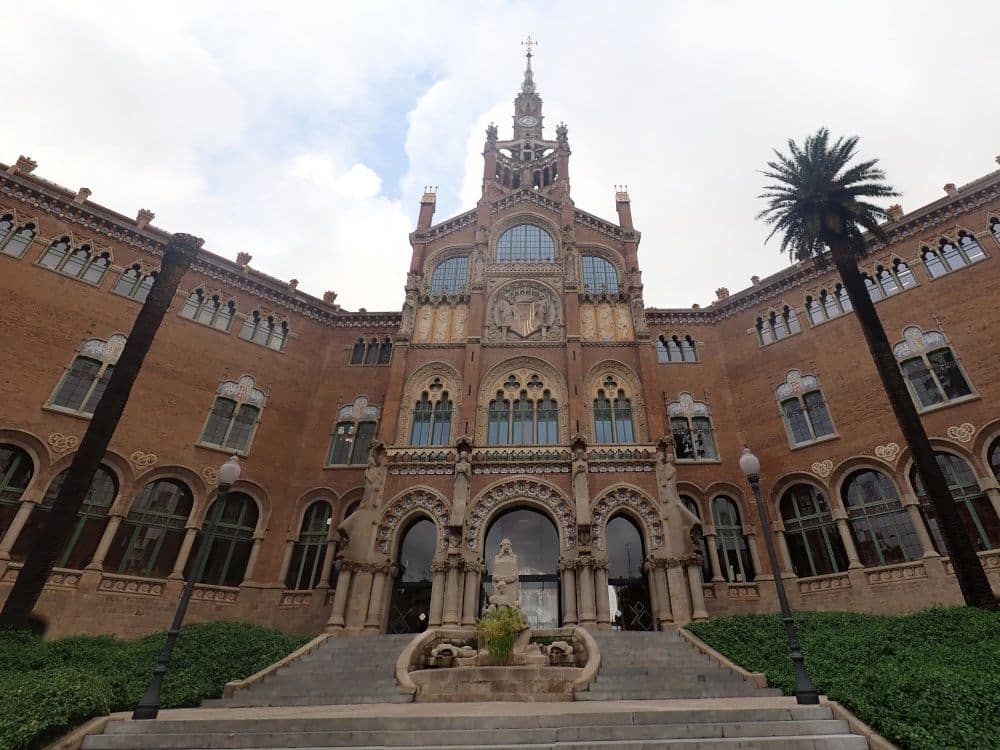
Palau de la Música Catalana
The Palau de la Música Catalana is an architectural jewel of Catalan Art Nouveau and the only concert hall built in this style. Construction was from 1905 to 1908. It served as a home for the Catalan Choral Society, the Orfeó Català, founded by Lluís Millet i Pagés and Amadeo Vives in 1891.
The building is located on the site of the former monastery of Sant Francesc de Paula. A wrought iron lamp survives from the monastery and is hanging in the Lluís Millet room.
The small site and the high price of the land in central Barcelona forced Domènech i Montaner to fit the auditorium into a tight grid of streets. This limited the views of the building from the exterior. He also had to find ingenious solutions to provide sufficient space for the stage and to include the offices and archives of the Orfeó in the building.
His solution was to put the box office, reception, main bar and rehearsal space on the ground floor. The auditorium starts from the first floor and spans the height and width of the building, allowing for the huge windows on each side.
The church of the former monastery survived until very recently. It was demolished to provide more space for an extension of the Palau in 2003. This project used the space to open a square which shows the huge stained-glass windows of the Palau de la Música that were previously hidden behind the old church. Under the large square is the Petit Palau, a new multi-purpose hall with a capacity for 600 people.
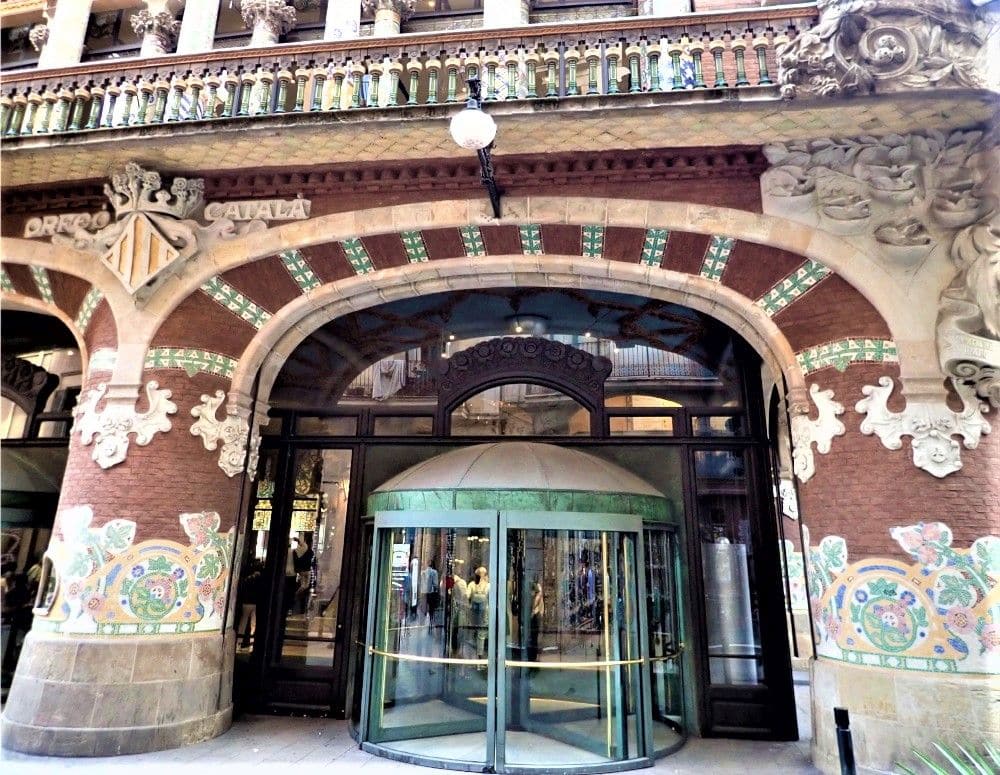
Why are Palau de la Música Catalana and Hospital de Sant Pau a UNESCO World Heritage site?
Both buildings are masterpieces of Barcelona Modernista architecture, and both are by Lluís Domènech i Montaner, a leader of this architectural movement. The two buildings made an important contribution to 20th-century architecture “both as manifestations of human creative genius and works of art,” according to UNESCO.
What can you expect on a visit to these two buildings?
Hospital de Sant Pau (Recinte Modernista de Sant Pau)
The Administration pavilion is the building that you see from the street and is now conference space and some high-end rented office space. Within this building you will find the Lluís Domènech i Montaner room with galleried chapel. You reach this room via the grand staircase from the vaulted lobby with high ceiling and marble columns.
A common theme throughout this building is the stained-glass windows featuring the Sant Creu cross. The decoration is lavish for what was designed to be a hospital. In the basement of the administration building is a large hall with displays of pharmacology and period medical instruments. It is from here that you can access the white tiled subterranean passages linking all the wards.
Nuestra Señora de la Mercè pavilion is one of the wards that has been fully restored. Notable features are the cathedral-like vaulted ceiling with tiles in a bright turquoise and white pattern. Today it houses an exhibition. The walls are also tiled in a decorative pattern with the crest of Sant Creu above the windows. Also a ceramic display shows some pieces that you cannot see from the ground such as chimney decorations.
Sant Salvador pavilion is another ward that has been restored with a similar tiling pattern as Nuestra Señora de la Mercé pavilion and is also an exhibition space. At the end of each ward is a solarium with large bay windows. The solarium was a space designated for recovery before discharge from the hospital. The solarium of this ward is restored to its original form with a mosaic domed ceiling.
Sant Leopold pavilion is also a restored ward. Here, you will find the main patient area set out with period beds with a heating radiator in the centre of the ward. This solarium is also restored.
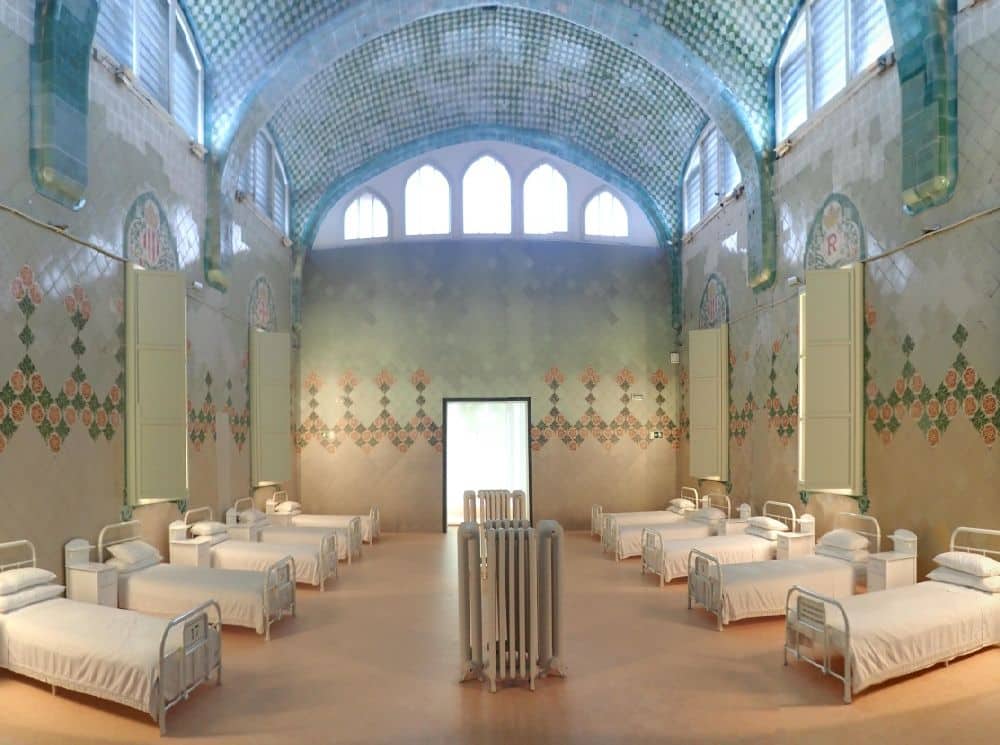
The final space to explore is the hospital garden. This is a patio and raised beds area between all the wards and was considered an additional space to promote healing before discharge from the hospital. It also served as a space where visitors could visit patients. Not all of the pavilions are open as museum space (some are private offices) but around the garden you can find interesting crests and mosaics in the brickwork of the multiple pavilion buildings.
Hospital de Sant Pau is a reflection of the great advances in citizens’ rights and facilities during the late 19th and early 20th century, before the Spanish Civil War put an end to the very forward-thinking Socialist Catalan society and government.
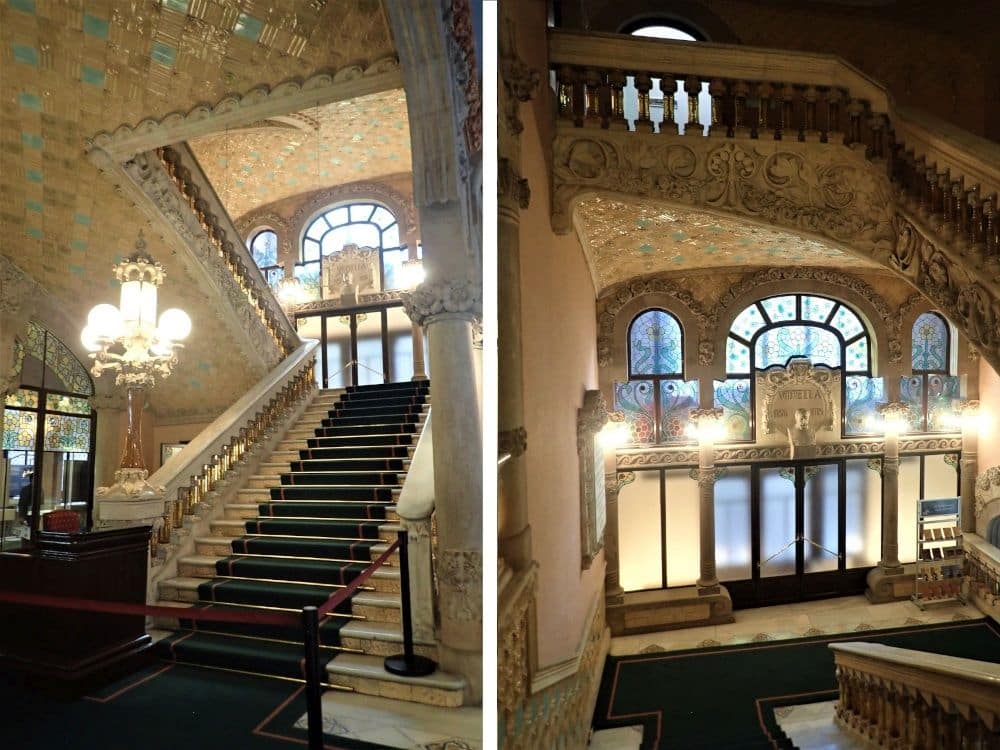
Palau de la Música Catalana
The guided tour of Palau de la Música Catalana starts in the reception hall, then proceeds to a small rehearsal chamber, on the ground floor behind the bar and beneath the stage. Here you sit in a small auditorium and hear an introduction to Palau de la Música.
Once the introduction is over, the group is left in the ground-floor café/bar area. Here you can admire the ornate brick columns decorated with ceramic enamelled flower capitals that lead into the decorative brick-arch roof. In the centre of the room is a beautifully carved dark wood bar with stained glass. I recommend waiting until the end of the tour to purchase a drink or snack in this bar.
When the group is called, you go through some ornate wooden doors onto the main vestibule and grand staircase up to the first floor. The staircase is decorated with bright tiles of a yellow and green hue and uplighting from ornate lamps on the staircase, which has gold leaf balustrades.
On the first-floor landing is the Lluís Millet Room, which faces onto the street via high stained-glass windows. It has a balcony of more ornate columns decorated with floral mosaics. The brick arches hide the underlying steel frame of the building. This room is a rest area for intermission and contains bronze bust sculptures of all the prominent musical directors that have tenured at Palau de la Música.
Next you will enter into the auditorium stalls area where you can look up at the magnificent domed stained-glass skylight. You can also see close up the plaster surround of the stage mouth with galloping horses, chariots, shields and crests. Also on the stage is a pipe organ and another skylight. Around the perimeter of the semi-circular stage are plaster muses jumping out of the trencadis (mosaic made from broken, irregular-shaped tile pieces).
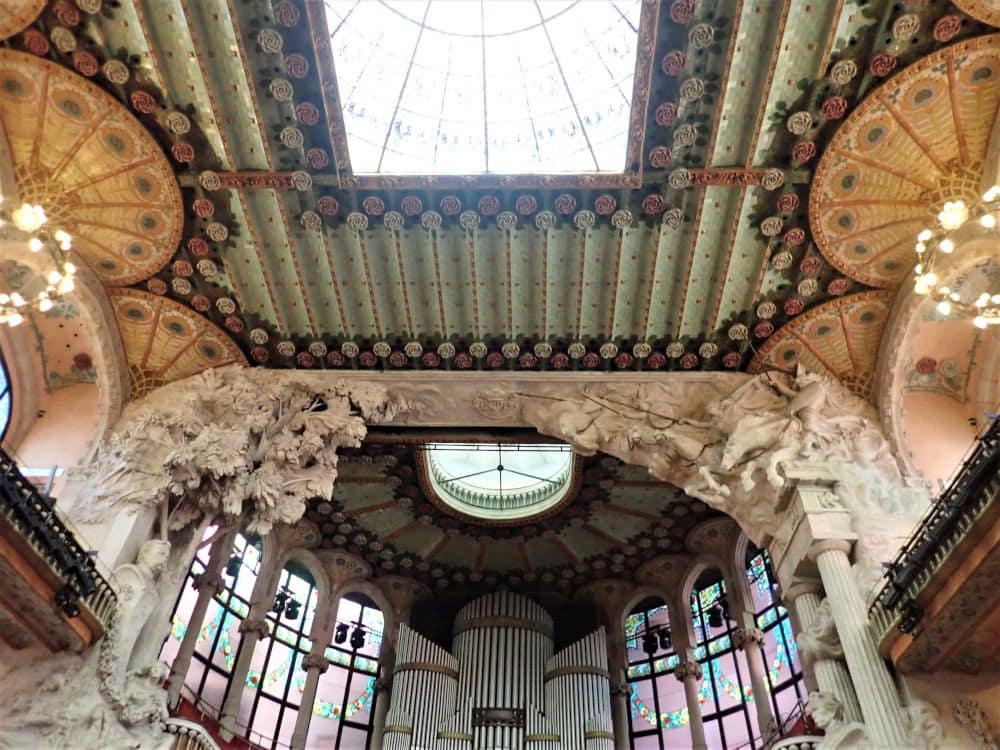
On the third floor of the building, you’ll see the surrounding tiered box seating. You are permitted to walk around the horseshoe-shaped seating area. Note that every seat has perfect sightlines to the stage.
On the fourth floor is another intermission room with a small bar. From here you enter the upper tier of the horseshoe-shaped seating area as well as the rear ramped seating area (the rafters), which is also highly decorated with plaster moulds of galloping horses. Here you will hear an explanation of the acoustics of Palau de la Música. From this level, I recommend walking around to the left (when looking at the stage) of the auditorium seating area, where you can see out of the stained-glass windows.
Finally, the tour heads down a modern staircase in the extension. It has glass panelling to allow you to appreciate the ornate brickwork of the outer walls. These stairs take you back to the ground floor bar, where you can order a drink and go outside. Here on this patio, you will find a large statue of Lluís Millet.
When you exit the Palau de la Música, note the small box office built into the central column of the front façade. Along Carrer de Sant Pere Més Alt, on the corner of Palau de la Música, is a modern monument called Carmela by the local artist, Jaume Plensa.
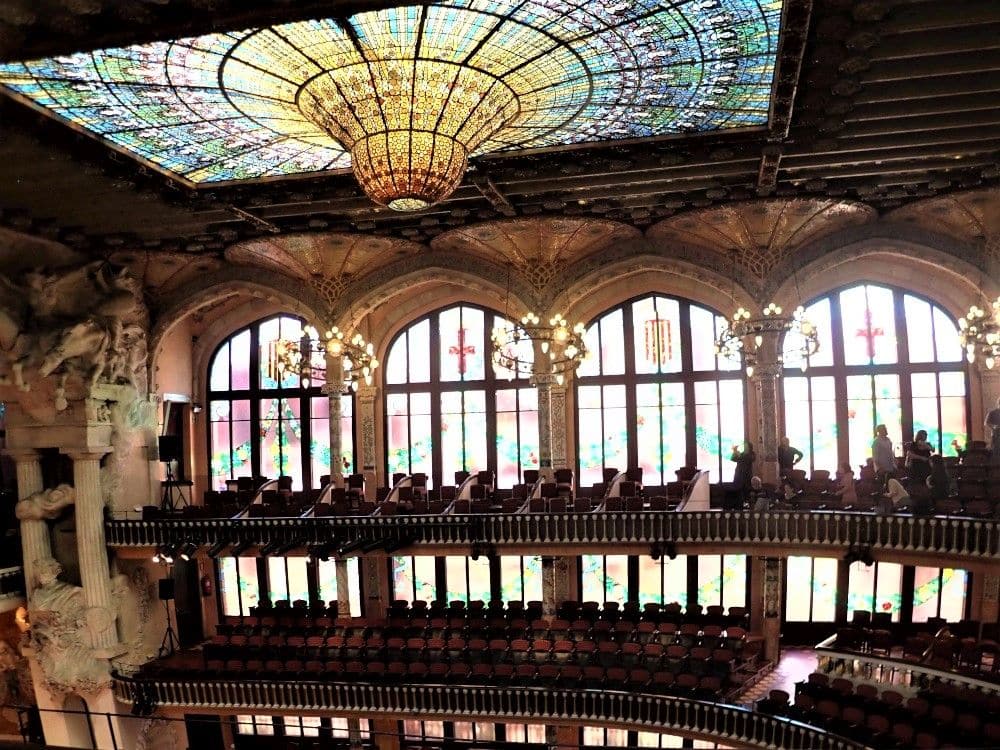
Are the Palau de la Música Catalana and Hospital de Sant Pau both worth visiting?
These are both buildings that you should make time to visit. Although Lluís Domènech i Montaner was a contemporary of Gaudí, his works do not garner the obsessive tourist attention that Gaudí´s La Sagrada Família, Casa Batlló, La Pedrera and Parc Güell (also a UNESCO site ensemble) do. This is a huge plus if you want to visit something truly beautiful and have the space around you to take in the vastness of the ornate spaces, without views obstructed by selfie sticks and too many visitors.
What sorts of travelers would like these two buildings?
Anyone who likes Gaudí’s work will like these buildings too. Pretty much anyone with any interest in architecture will enjoy visiting them.
Tips for visiting the Palau de la Música Catalana and/or Hospital de Sant Pau
2023 is the centenary anniversary of the death of Lluís Domènech i Montaner (b. 30 December 1849, d. 27 December 1923). Expect special exhibitions about this great architect, famous for buildings of public use (hospital, music hall, grand restaurants and factories).
The Recinte Modernista de Sant Pau is at one end of Avenida Gaudí, a diagonal pedestrianised boulevard cut through Barcelona´s grid street layout to link two of Barcelona’s most important modernist masterpieces. Gaudí´s La Sagrada Família is at one end and Domènech i Montaner´s Hospital de Sant Pau at the other.
My advice is to take both attractions as a half-day (or 3/4 day) activity. First visit La Sagrada Família at 9 or 10am. I recommend this hour because first thing in the morning there are fewer people. Also the angle of the sun through the stained-glass windows of the basilica paints the interior in an array of bright colours.
Buy your admission ticket to Hospital de Sant Pau ahead of time, and also your ticket to La Sagrada Familia.
After La Sagrada Família, take a walk along Avenida Gaudí, noting the ornate wrought-iron lampposts and fountains and monuments. This is a pedestrian street with bars and cafes and a good place to grab a snack or early lunch.
At the Palau de la Música Catalana, I recommend the guided tour because you hear explanations that you might not get in the brochure for the self-guided tour. You can also ask questions.
If you’re going to be spending a few days in Barcelona, it might be a good idea to buy a GoCity pass, which allows you access to lots of Barcelona’s sights.
Use the map below to find accommodations in Barcelona.
Read more about Catalan Modernism in architecture here.
Where are these two architectural gems?
Hospital de Sant Pau
At the top of Avenida Gaudí you will find Recinte Modernista de Sant Pau. You enter via the ornate wrought-iron gates on the corner of Carrer de Cartagena and Carrer de Sant Antoni Maria Claret 167. Note the Sant Creu cross motifs on the gates.
La Sagrada Família is served by metro stop ‘Sagrada Família’ on the blue (L5) and purple (L2) lines. Recinte Modernista de Sant Pau is served by a metro stop called ‘Sant Pau | Dos de Maig.’ The station is one stop away along the blue line from la Sagrada Família.
The nearest pay parking is in the new hospital behind Recinte Modernista or using any ´blue´ parking spots and paying for up to two hours. Personally, I recommend using the metro because Carrer de la Marina is a pedestrian street. Finding parking nearby is difficult if you do not have a resident’s permit to park in the ´green´ zones in the neighbourhood.
Palau de la Música Catalana
The building is located in the Sant Pere district just above El Born neighbourhood, near plaza Urquinaona in Carrer de Sant Pere Més Alt 4-6. This is the address you need to use for the guided tour, even though its official address is C/ Palau de la Música, 4-6, 08003 Barcelona. This refers to the new square built on the side of the building.
Palau de La Música is in a narrow pedestrian street. The nearest pay parking is below Barcelona Cathedral square, off of Via Laietana: Aparcament Saba Catedral. I recommend using the TMB metro instead: the stop is Urquinaona on the red (L1) and yellow (L4) lines.
For more information about visiting hours, tickets, temporary exhibitions, and self-guided or guided tours, consult the Recinte Modernista de Sant Pau website and/or the Palau de la Música website. You can also find a listing of Palau de la Música’s live shows here.
Have you been to Barcelona and seen these two art-nouveau buildings? If so, do you have any additional information or advice about this UNESCO World Heritage site? Please add your comments below!

